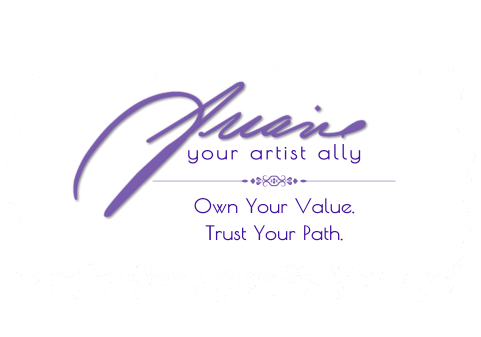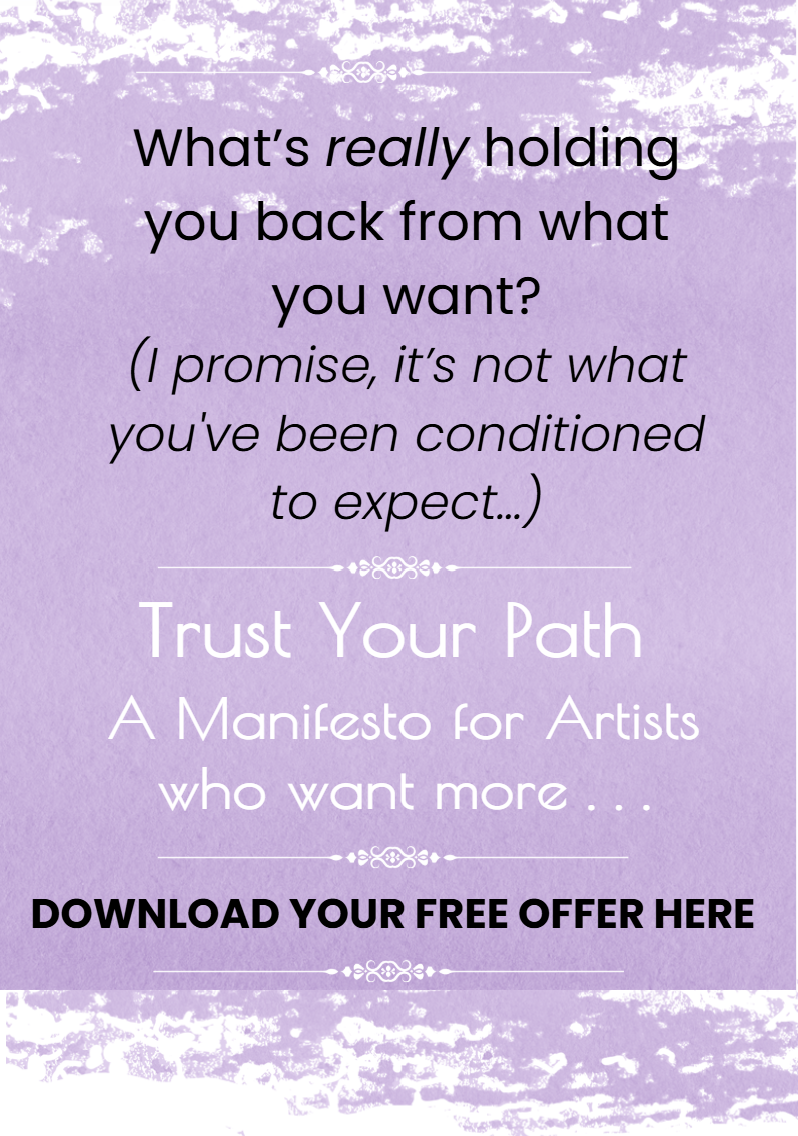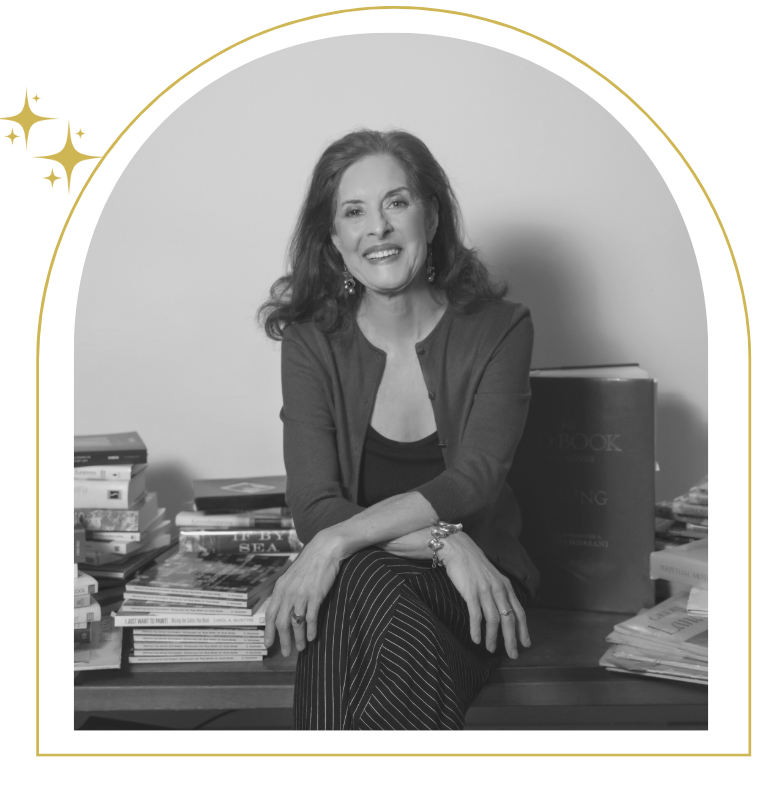HOW TO WRITE AN ARTIST STATEMENT: STEP ONE
Self-promotion vs. Connection
For too long, self-promotion has been chained to marketing. But when you fully grok that your success depends upon how you connect, one human to another, the self-promotion chains fall away.
So, how does that connection work?
An effective artist statement creates a personal connection between the artist, the artwork, and the audience because it stimulates our human thirst for “story.”
Story, in turn, triggers longer memory storage, and increases the sticky factor because art with an artist statement immerses your viewer in two languages: visual (the art) and linguistic (the words you choose).
For people who see what you do, a well-written statement keeps your name in front of them even longer.
Name recognition, or branding, is nothing more than remembering—in the virtual storm of constant stimulation drowning our 21st Century lives—what has struck a deep chord within us.
This means you need to …
Forget jargon.
Forget academic-sounding gobbledygook.
Forget hiding behind technical details.
Forget lists of features.
Get personal.
Be vulnerable.
Be real.
The secret lies in wrapping your brain, and heart, around the way an artist statement expands the bridge of connection between your art and your audience.

HOW TO WRITE AN ARTIST STATEMENT: STEP TWO
Recognize the Resistance Roadblock (R&R)
First, remember that as an artist you come with a solid dose of creative resilience. I’m reminding you of this because writing about yourself can be daunting.
And while some people love to write, and some people don’t, what both have in common is a reluctance to write about themselves.
It feels self-serving.
It feels like unwarranted boasting.
It feels as if you’re trying to get away with something.
It feels icky.
And when you are feeling this particular brand of feels, that’s when you will want to hide behind jargon, academic-sounding gobbledygook and technical details because these give you a cushion of self-protection against what you must do: Get personal. Be vulnerable. Be real.
Oh, my.
When you need for an artist statement, up pops the inevitable: The I-don’t-want-to-talk-about-myself Reluctance Roadblock (R&R)
It’s built into the process.
So, what do you do about that?
Muddle through?
Hire someone else to write it?
Find something else to do—anything?
No, you fortify yourself with good old information.
Because if you don’t know what an artist statement really is, you can’t begin to write an effective one. And if it isn’t effective, then what’s the point?
Most artist statement definitions are too general to be useful. They fail to tell you first, what your artist statement is supposed to do for the person reading it, for you the artist writing it, and how these work together.
Here’s my definition that’s stood the test of time since it came out in 2002. Yup! 2002. Before then, and since then, no one had bothered to actually analyze artist statements. It was just this thing artists were asked for in their portfolios, and you had to cobble it together as best you could.
Which is what led to the very real impression that artist statements are useless.
Because, in the beginning, a lot of them were based on language that had nothing to do with connecting human to human. Artists felt they had to defend and explain their work, which annoyed the artists and baffled, or worse, turned off their readers.
Here’s my straightforward definition:
======================================================================
An artist statement is a written, personal reflection on your insights about your relationship to what, how, and why you do what you do—from your perspective as the artist-creator.
======================================================================
You have permission to reveal as much, or as little, as feels comfortable keeping in my mind that your viewer sees you, the artist, as a kind of magician. They don’t want to be told what to see. They don’t want to spoon-fed an explanation.
They want a peek behind the curtain into your life as an artist. A peek. A prelude. An excerpt. In short, they want to know what it feels like to be an artist.

HOW TO WRITE AN ARTIST STATEMENT: STEP THREE
The Nuts and Bolts of Your Artist Statement
An ideal length for your artist statement is 3 paragraphs on each aspect, in this sequence:
What you do.
How you do it.
Why you do it.
Each artist statement paragraph is between 5 to 7 sentences, depending on what you want to say.
The first two will be the easiest.
It’s the “why you do it” that dashes ice cold water on the whole thing.
Even though, I guarantee, you use words about and around your art all the time, most of this is so commonplace and instinctive you don’t even realize you are doing it.
I’m always amused when I hear an artist being interviewed and someone is asking them questions about their work, how effortlessly they can talk about it. And quite often they will say something like “I really don’t have words for xxxx…” and then they will continue to say a whole bunch of words about “xxxx.”
It’s as if the visual process of making art has seduced them into believing that visual language is so superior to linguistic language that it’s impossible to bridge this divide.
But, as the interview continues with nothing but words, that conceit is destroyed, while the artist continues on oblivious to the Grand Canyon between what they say and what they are, in fact, doing.
But, I digress…
Here’s how you get around the why you do what you do roadblock:
- Write a first draft for the two artist statement paragraphs on what and how, so you practice writing and realize there are no monsters hiding under the bed.
- Pick up an old fashioned, cheap spiral notebook, and any writing implement you like.
I recommend staying away from note taking on your phone because, as hard as this is to understand, the physical activity of hand writing stimulates a different area of your brain that connects with the material you are going to want for your why.
a. Take this notebook wherever you work, take it to bed, take it when you travel around… because, in all of these cases you will inevitable find yourself thinking about your work.
The intention is twofold: 1) Write at the top of your first page: Why Do I Do The Work I Do? You are priming your brain to pay attention. 2) Practice catching yourself thinking about your work and jot down enough keywords so can return later and know what it was.
This will be especially challenging in your work/production space. When you forget, notice that you’ve forgotten. Be gentle with yourself, then ask the main question: Why do I do the work I do? And begin again.
b. Practice this for at least 3 weeks. It will take a minute to habituate yourself to this exercise, but the payoff is huge!
3. Find a buddy and let them interview you about your work.
Between your notebook of artist-statement thoughts-made-conscious and the interview, you will have enough material to write your third and last paragraph.

HOW TO WRITE AN ARTIST STATEMENT: STEP FOUR
Patience, Patience, Patience…
From Rough Draft to the Artist Statement Final Draft
The best professional writer’s tip I can give you is this: write your first draft then put it away and out of mind for at least two weeks.
After two weeks you can go through your artist statement first draft again.
You can do this in one sitting, or take it slower and do it in several sessions.
This time, read it out loud. You’ll instantly hit sentences or phrases that feel as if you just tripped over a tree root. These are where you go to work.
Does a word need changing? Is the sentence too complicated? Is the thought something only you would understand?
Writing is a process, a verb. Writing is alive, changing as you change. Writing does not lock you in. Don’t like a word? Erase it.
If you want to use a program like Grammarly or ProWritingAid to check your punctuation or grammar, that’s fine. Just don’t let an AI program do the writing for you because AI ain’t you!
Unless you are sophisticated with setting up AI prompts so it replicates your unique voice, AI has its own voice, which will come across subliminally no matter what. I know because I’ve played around and found that it writes with a kind of stiff quality. It can’t improvise or flex and bend easily.
After you’re satisfied with grammar, spelling, and punctuation, notice the tone of your artist statement.
Is it quiet and simple?
Bold and brash? Sophisticated and elegant?
Is it earthy and grounded?
Ethereal and wispy?
Is it wide and flowing?
Or narrow and steep?
Does this tone reflect the tone of your art work?
Do you keep the same tone of voice throughout, or does it shift at some point?
Is this shift jarring or smooth?
If want to take your writing to the next level, try some of these writing techniques:
- Replace general statements with specific details. “I like oil paints,” becomes, “I like the way oil paint smells, a bit forbidden, like sniffing glue. I like the wet look of it slipping off my brush and onto the canvas.”
- Use as many of the senses as you can: sight, sound, smell, texture/touch, taste. These hook a reader by exciting primal areas of the imagination.
- Try repetition: This goes to the heart, this goes to the spirit, this goes to the soul….
- Use variation on a pattern: of the people, for the people, by the people…
- Link the beginning of your artist statement to the end by repeating a phrase, a word, or a sentiment in the last paragraph that shows up in your first paragraph.

HOW TO WRITE AN ARTIST STATEMENT: STEP FIVE
Time To Test Out Your Artist Statement
Find three people who you trust to be honest and kind.
Give them your brand-new artist statement and ask for their honest response.
Because it’s hard for people to critique something without guidelines, offer them these.
They can write their responses or talk to you, but the responses need to be in this order because a critique can be difficult to hear:
- Tell me what delighted you.
- Tell me if it flowed easily.
- Tell me what you think needs to be clearer.
- Tell me if you have a specific suggestion for a word, a phrase, a sentence, or even a paragraph.
Then, implement any suggestion that truly resonates with you.
You are the final arbiter of this artist statement, and like the artwork you do, only you can deeply know what feels authentic and true.

P.S. Before presenting your artist statement, you have to write it.
No worries, I developed an easy process streamlined for artists.
Follow the guidelines in my definitive book on artist statements: Writing The Artist Statement: Revealing The True Spirit of Your Work — one easy chapter at a time.
Write it once, and you’ll have a system in place as your artwork evolves.








